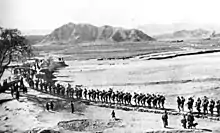Xinhai Lhasa turmoil
The Xinhai Lhasa turmoil (Tibetan: ཆུ་བྱི་དམག་འཁྲུག་, Wylie: chu byi dmag 'khrug; Chinese: 辛亥拉薩動亂) was an ethnic clash in Lhasa, Tibet, as well as a series of mutinies following the Wuchang Uprising. It effectively resulted in the end of Qing rule in Tibet.
| Lhasa turmoil | |||||||
|---|---|---|---|---|---|---|---|
 After the end of the Qing empire, Sichuan New Army left Lhasa in 1912. | |||||||
| |||||||
| Belligerents | |||||||
|
|
| ||||||
| Commanders and leaders | |||||||
|
13th Dalai Lama Tsarong Dazang Dramdul 3rd Tsomonling Rinpoche Xie Guoliang |
Lianyu Zhong Ying | ||||||
Background
The Wuchang Uprising unfolded on October 10, 1911, and marked the beginning of the Xinhai Revolution. Turmoil in the frontier regions of China began to spread.[1]: 58–59 The revolutionaries led by Sun Yat-sen insisted on "getting rid of the Tartars" and rejected the Manchus, creating a new government based completely on Han-dominated China proper.
Turmoil in Tibet
The influence of the Wuchang Uprising rapidly spread to the frontier region. Qing armies in Tibet ended up struggling against each other, and as a result, Tibet fell into a state of anarchy. In the winter of 1911, the Qing Governor of Sichuan, Zhao Erfeng, was executed by radicals, and the situation turned worse as Xikang fell into turmoil as well. As a result, the Dalai Lama was able to eliminate Qing influence in Tibet and return as the sole administrator of the region. The Qing army in Tibet was unable to resist the Dalai Lama's forces, and fled back to inland China via India.[1]: 59
See also
References
- Melvyn C. Goldstein (18 June 1991). A History of Modern Tibet, 1913-1951: The Demise of the Lamaist State. University of California Press. ISBN 978-0-520-91176-5.